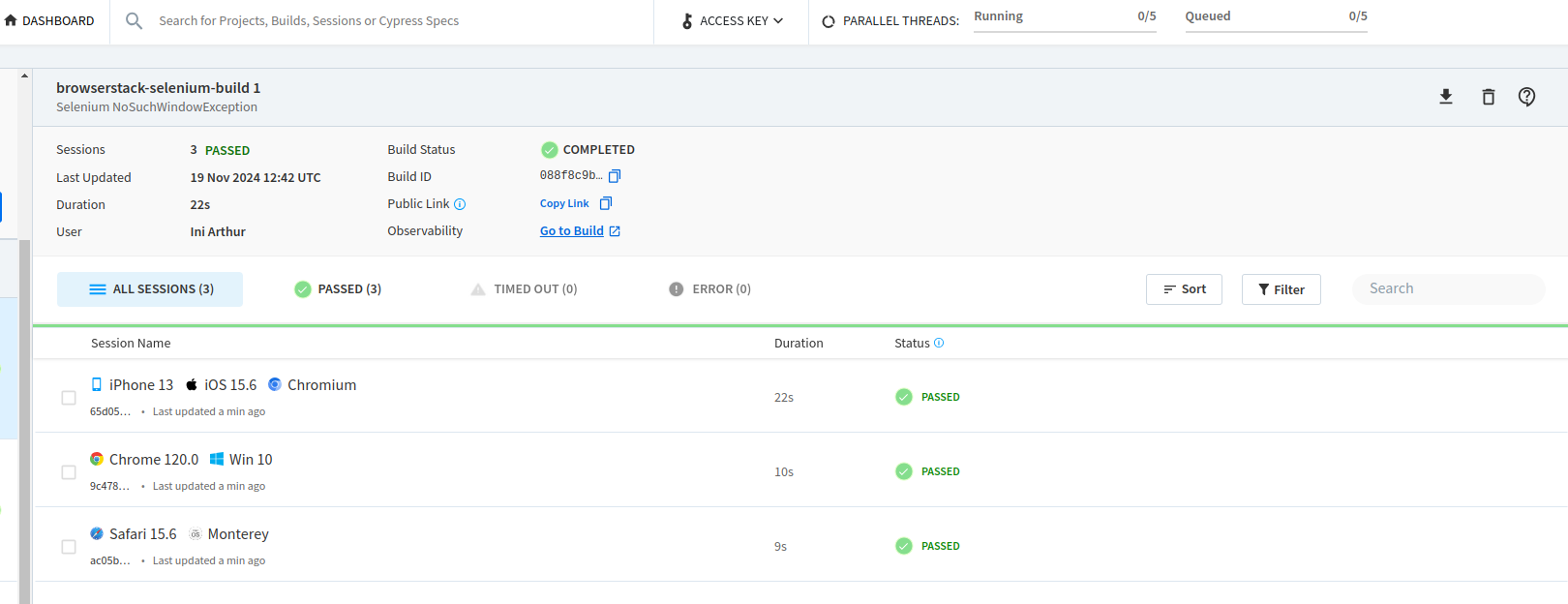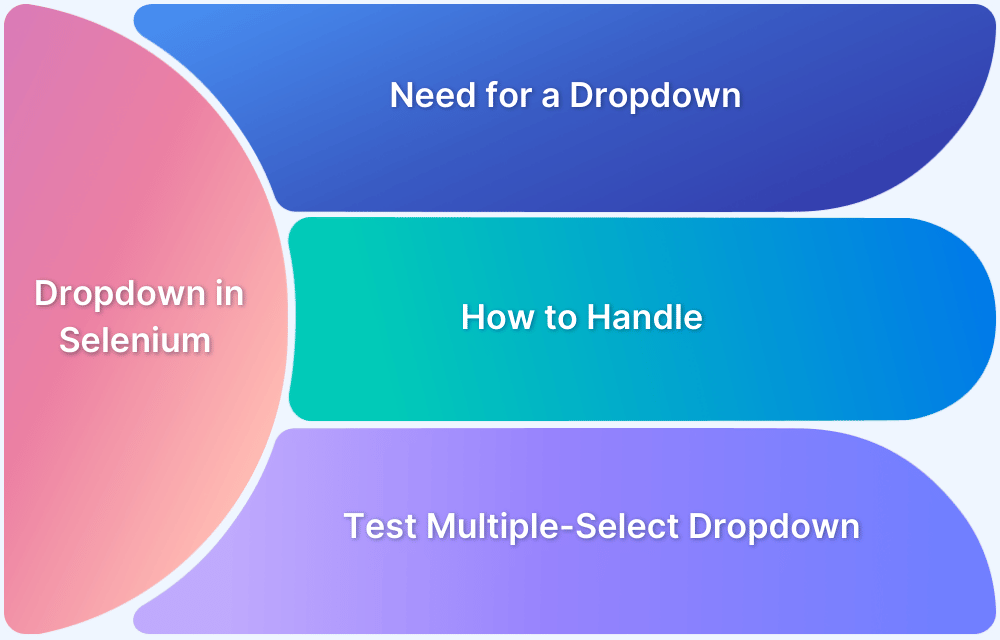Similar to NoSuchElementException and StaleElementReferenceException, NoSuchWindowException is a common error Selenium users face during automation.
Overview
What is NoSuchWindowException in Selenium?
NoSuchWindowExecption is an exception raised by the Selenium WebDriver while attempting to access a non-existent browser window during test execution.
When does NoSuchWindowException occur?
- When Webdriver tries to interact with a closed window
- While switching to another tab
- When accessing a tab before it fully opens
Handling NoSuchWindowException in Selenium
- Avoid Accessing Closed Windows
- Provide a Valid Window Handle
- Use Wait Methods
- Conditional and exception handling
This tutorial will focus on the NoSuchWindowException, that often occurs during a failed attempt to interact with a browser window.
What is NoSuchWindowException?
The NoSuchWindowExecption is a common exception raised by the Selenium WebDriver while attempting to access a non-existent browser window during test execution. It occurs when switching to a window with an invalid name or tab that has been previously closed.
Read More: Exception Handling in Selenium WebDriver
When does NoSuchWindowException in Selenium occur?
Here are a few reasons why your Selenium automation script might throw the NoSuchWindowException during a test:
- This exception could occur when the WebDriver attempts to interact with a closed browser window or tab.
- When switching to another tab, an exception is raised if the window name is incorrect or the window handle is invalid.
- When an error is encountered for any attempt to access a new tab before it is fully opened.
Here is an example of a case where you could encounter NoSuchWindowException
Filename: test_window_exception.py
from selenium import webdriver
def test_window_exception():
with webdriver.Chrome() as driver:
# Navigate to Selenium homepage
driver.get('https://seleniumhq.github.io')
# Set name for first tab
driver.execute_script("window.name = 'Selenium';")
# Get name of first tab
first_tab = driver.execute_script("return window.name;")
print(f'First tab name is: {first_tab}')
# Get page title
title = driver.title
print(title)
# Open new tab
driver.execute_script("window.open('https://www.google.com', '_blank');")
# Switch to new tab
driver.switch_to.window(driver.window_handles[-1])
# Set name for new tab
driver.execute_script("window.name = 'Google';")
# Get name of new tab
new_tab = driver.execute_script("return window.name;")
print(f'New tab name is: {new_tab}')
# Attempt a switch to previous tab
driver.switch_to.window('main')
assert title == driver.title, f'Expected {title} as title'The above code snippet illustrates a typical NoSuchWindowException. First, import the web driver module from Selenium. Define a test_window_exception function that would be executed during the test.
Create a context manager to initialize an instance of the selenium WebDriver as driver. This is done so that the driver instance can be closed automatically after the code has completed execution within the Python with the statement. The driver.get() method loads the Selenium homepage in the current browser session.
The driver.execute_script() method is used to set the name ‘Selenium’ for the first window tab. Another tab is launched, and the name is set to the same driver.execute_script() method.
Using the driver.switch_to.window(driver.window_handles[-1]) method, you can switch to the new tab that was launched.
Driver.window_handles[-1] returns the last window in the current session windows handle list. To switch back to the first tab, use the driver.switch_to.window(‘main’) method. However, passing ‘main’ as an argument to the method results in the NoSuchWindowException error because there is no window tab with that name during test execution.
Read More: Desired Capabilities in Selenium Webdriver
How to Handle NoSuchWindowException in Selenium
Here are a couple of ways you can handle the NoSuchWindowException during the execution of your test scripts.
- Avoid Accessing Closed Windows: Ensure that you do not try to access or interact with windows that have been previously closed.
- Provide a Valid Window Handle: Always make sure that you provide a valid window handle or name when switching to another tab.
- Use Wait Methods: Apply Selenium wait methods to your test scripts to ensure that a new window is completely loaded before attempting to access it.
- Leverage conditional and exception handling: Use conditionals and exception handling in your automation scripts to gracefully handle any exceptions where they are unavoidable.
Here is an example for handling NoSuchWindowException:
Filename: test_window_exception.py
from selenium import webdriver
from selenium.common.exceptions import NoSuchWindowException, WebDriverException
def test_window_exception():
with webdriver.Chrome() as driver:
try:
# Navigate to Selenium homepage
driver.get('https://seleniumhq.github.io')
# Set name for the first tab
driver.execute_script("window.name = 'Selenium';")
# Get name of the first tab
first_tab_name = driver.execute_script("return window.name;")
print(f'First tab name is: {first_tab_name}')
# Get page title
first_tab_title = driver.title
print(f'First tab title: {first_tab_title}')
# Open a new tab
driver.execute_script("window.open('https://www.google.com', '_blank');")
# Switch to the new tab
if len(driver.window_handles) > 1: # Ensure there are multiple tabs
driver.switch_to.window(driver.window_handles[-1])
# Set name for new tab
driver.execute_script("window.name = 'Google';")
# Get name of the new tab
new_tab_name = driver.execute_script("return window.name;")
print(f'New tab name is: {new_tab_name}')
else:
print("No new tab was opened.")
# Attempt to switch back to the previous tab safely
if any(handle for handle in driver.window_handles if driver.execute_script("return window.name;") == 'Selenium'):
# Safely switch by index
driver.switch_to.window(driver.window_handles[0])
assert first_tab_title == driver.title, f'Expected {first_tab_title} as title'
print("Switched back to the first tab successfully.")
else:
print("First tab is not available to switch back to.")
except NoSuchWindowException as e:
print(f"NoSuchWindowException caught: {e}")
except WebDriverException as e:
print(f"WebDriverException caught: {e}")
except AssertionError as e:
print(f"AssertionError: {e}")
finally:
print("Test execution completed.")A few changes were made to the code snippet discussed earlier.
- The code was wrapped within Python’s try/except code block.
- An if statement was added to check if there is more than one window in the current session.
- Added another if statement to check if the window being switched to does exist.
Read More: Selenium Python Tutorial (with Example)
To execute the script via your terminal, use the command below:
pytest -s
Below is the result as displayed on the terminal:
How to use BrowserStack to Execute Selenium Pytest Browser Automation Script
Using a cloud testing platform like BrowserStack Automate to execute test scripts is more convenient as you don’t have to manage dependencies yourself. With BrowserStack, you also get to access a vast real-device cloud to validate the functionality and consistent working of your app across 3500+ real device-OS-browser combinations.
Here’s how you can use BrowserStack Automate to execute the Selenium Pytest Browser Automation Script
Prerequisites
Ensure you have Pytest v4+, Python3, and Pip3 installed on your local machine.
Step to Execute the Selenium Pytest Browser Automation Script
Here BrowserStack Automate is used to execute the code snippet in the previous section with the following steps:
Step1: Sign up on BrowserStack
Step 2: Install the BrowserStack SDK within your project’s root directory and execute the following command:
python3 -m pip install browserstack-sdk browserstack-sdk setup --framework "pytest" --username "YOUR_USERNAME" --key "YOUR_ACCESS_KEY" pip show browserstack-sdk
Step 3: Modify the browserstack.yml file within your project’s root directory as you see fit.
userName: <YOUR_USERNAME> accessKey: <YOUR_ACCESSKEY> framework: pytest platforms: - os: Windows osVersion: 10 browserName: Chrome browserVersion: 120.0 - os: OS X osVersion: Monterey browserName: Safari browserVersion: 15.6 - deviceName: iPhone 13 osVersion: 15 browserName: Chromium deviceOrientation: portrait parallelsPerPlatform: 1 browserstackLocal: true buildName: <BUILD_NAME> projectName: <PROJECT_NAME>
Step 4: Run the following command to execute your test:
browserstack-sdk pytest -s test_window_exception.py
Step 5: Go to your BrowserStack dashboard and click on “Automate” on the left sidebar.
You will see a result that looks as depicted below:
Why is Testing on Real Devices and Browsers important?
The importance of testing applications on real devices and browsers can never be overstated because it instills confidence in the developers that a piece of software being shipped is reliable after rigorous testing. It also indicates that end users of such applications would experience a very minimal incidence of bugs and crashes.
Testing on real devices and browsers reveals first-hand issues that potential users of a piece of software would encounter. Issues like disparity in UI across different devices can be rectified by simulating human interaction with an application to determine how user-friendly it is.
One constraint about testing in this manner is the inability to access hundreds of devices to conduct testing on. Conducting tests on a local device is limiting, and this is why developers and many enterprises embrace the use of online cloud testing platforms like BrowserStack.
A feature like BrowserStack Automate solves some problems related to testing in the following ways:
- Offers 3500+ desktop and mobile devices, OS, and browser versions for cross-platform and cross-browser testing.
- Simulation of real-world user conditions across multiple platforms, devices, and browsers.
- Identification of faults related to specific devices.
- Provision of more reliable and accurate results as you can configure tests to accommodate variations in network, hardware, and operating system.
- Compatibility across various versions of dependencies and browser-specific methods of rendering.
Conclusion
The NoSuchWindowException is raised anytime the Selenium WebDriver tries to access or interact with a target window because of an invalid name or previous closure.
This exception can be avoided when certain conditional statements are added to a test script to verify that the targeted window exists and valid window names or handles are specified when a switch is being made.
Remember to always use Selenium waits (implicit, explicit) to wait for the complete load of the DOM tree and targeted elements. Most exceptions you’ll encounter can be resolved when elements, window tabs, and page contents are allowed to fully load to completion.
For better convenience and access to multiple real devices, you can execute your Selenium Pytest scripts with BrowserStack Automate.









